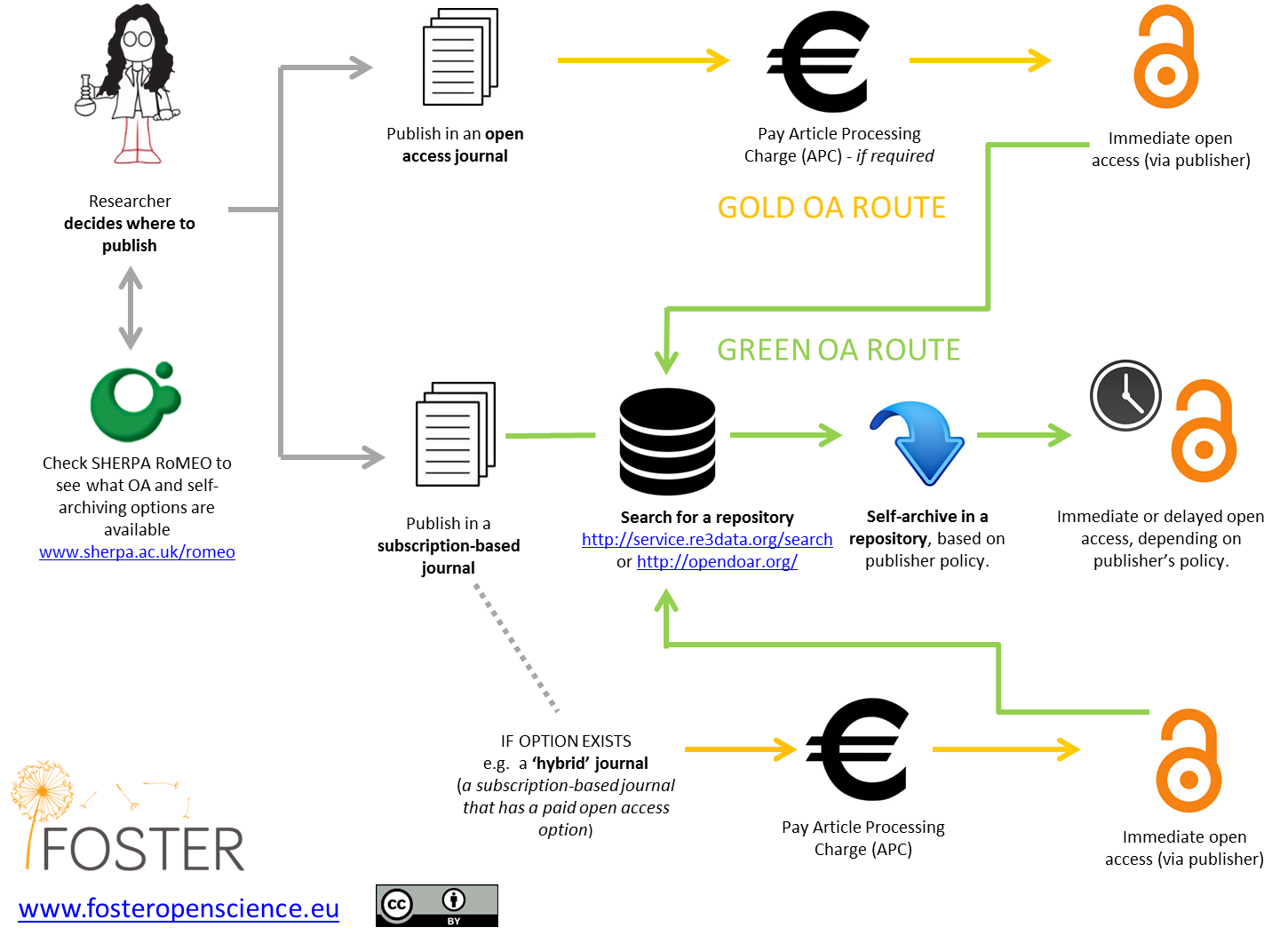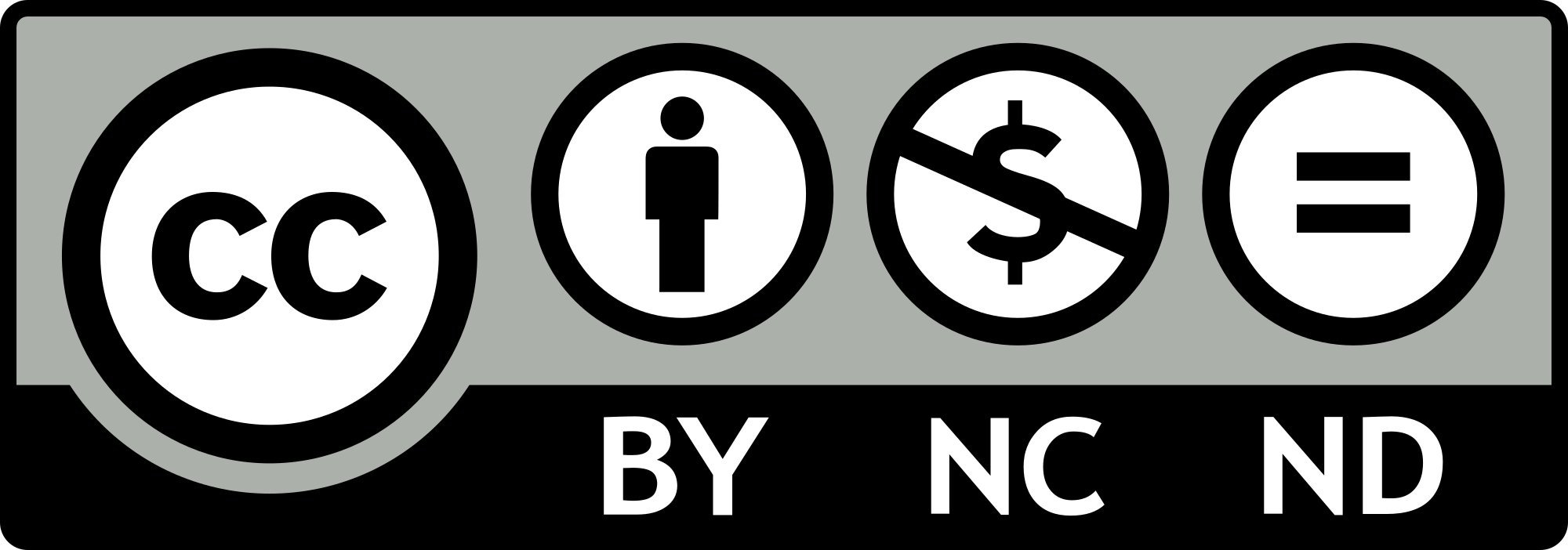Gold Open Access and Green Open Access
Gold Open Access (immediate Open Access) and Green Open Access (delayed Open Access) are the two main routes of Open Access publishing.
- With Gold Open Access, paying an Article Processing Charge (APC) ensures that the item is instantly available worldwide at no extra cost.
- Green Open Access denotes the secondary publication or self-archiving of scientific literature in an institutional or subject-specific repository (taking into account the respective publisher's conditions, which can be checked via Open Policy Finder (formerly Sherpa services)).
- Hybrid Open Access is a mix between Gold and Green Open Access.
The following visualisation illustrates the three main routes of Open Access publishing of scientific journal articles:

Image: Fostering open science, Source: http://www.dcc.ac.uk/blog/fostering-open-science
Why should I publish Open Access?
- Availability of own scientific work for the entire scientific community
- Improved visibility and thus increased citation count
- Free worldwide access to the work of colleagues
- Increased scientific exchange and more feedback
- Better reusability of scientific results
- More exploitation rights (and thus greater freedom of design) remain with the authors
- Less dependence on publishers and more transparency and competition in scientific publishing
- The public gains access to the results of scientific research
What are free licenses?
Copyrighted works are subject to the so-called moral rights and exploitation rights. In contrast to the personal rights, the exploitation rights are transferable (§ 24 UrhG (1)). A distinction is made between the usufruct (non-exclusive right to use the work) and the right of use (exclusive right to use the work). In publishing contracts usually rights of use are granted, so that the authors themselves have no exploitation rights.
With a free license, the author grants the users a work license. Content under a free license remains protected by copyright, but may be used within the scope of the respective license terms.
What are Creative Commons?
In order to ensure the legally clear and correct formulation of the license terms of free licenses, the organization Creative Commons was founded in 2001. The licenses, which were developed by Creative Commons and are freely available, allow the author to grant the user certain rights of exploitation as part of a work use permit, such as commercial or non-commercial use or further processing.
How do I recognise a Creative Commons (CC) license?
Documents with a Creative Commons license usually have the logo of the respective license as well as a text note on the license type and a link to the complete license text on the title page.

Example: This work is licensed under the Creative Commons Attribution-NonCommercial-NoDerivatives 4.0 International License. To view a copy of this license, visit http://creativecommons.org/licenses/by-nc-nd/4.0/.
Which Creative Commons (CC) licenses are there?
There are a total of six different licenses, which consist of four different modules. The four modules are:
- BY = attribution - The author and other parties designated to receive attribution must be named.
- NC = non-commercial - The work may not be used for commercial purposes.
- ND = no-derivatives - The work may not be changed, adaptations of the work are not permitted.
- SA = share alike - The newly created or adapted work must be passed on under the same license.
This results in the following six licenses:
- CC BY: Attribution
- CC BY-SA: Attribution-Share-Alike
- CC BY-ND: Attribution-No-Derivatives
- CC BY-NC: Attribution-Non-Commercial
- CC BY-NC-SA: Attribution-NonCommercial-ShareAlike
- CC BY-NC-ND: Attribution-NonCommercial-ShareAlike-NoDerivatives
More information about the individual licenses as well as the links to the abstracts and legal long versions can be found
here.
What are the advantages of CC licenses?
The biggest advantage for the author / creator is the widest possible dissemination of their work. Works under a CC license are freely searchable on the net, thus increasing the visibility and the probability that the work will be cited. In addition, by assigning a specific CC license, the author has the decision and control over what can be done with the work. The advantage for the user is, in addition to the free accessibility of the works, having exact knowledge as to which rights are granted and which are not. Both sides benefit from a high degree of legal certainty.
How can I prevent violations against the conditions set by my CC license?
Complaints for copyright infringement are possible in the context of the CC-licenses as with any other copyright license. Thus, CC-licensed works are subject to the same legal protection as works that are fully protected by copyright.
How can I publish under a Creative Commons license?
The first prerequisite is that it is a "work" in the legal sense, so that the copyright applies. In addition, you must be a holder of rights to the work: You must be the author / creator and may not have given the exploitation rights, for example, to a publisher. Co-authors must also agree to the licensing with a CC license.
If you meet these requirements, you can assign your work a CC license. The license is granted by inserting the logo of the respective license and the corresponding text note including the link to the license in your document.
On the Creative Commons website you will find help on choosing a license and the logos to download.
How do I cite a CC-licensed publication correctly?
The CC license must be specified as well as copyright and title. In the case of a print publication, the mention of the license suffices; in the case of an online publication, the link to the license must also be inserted. If the work has been edited, this must also be indicated.
Since there were country-specific versions for the CC licenses prior to the current 4.0 version, which were adapted to the respective state laws, the corresponding country code must also be specified for CC licenses up to version 3.0.
Example for quoting a journal article:
- Author, Title. In: Journal Name 12 (2012), 12-24, DOI: 10.1016/example.2012.12.024, CC BY-NC-ND 3.0
Example for quoting an image/a picture:
"Fake Journals" and "Predatory Publishing" are dubious business models by publishers and journals, which charge the authors money for services not provided. Quality control, such as peer review, is poor or non-existent. Reliable long-term availability of the articles is not guaranteed. Often, scientists are named as publishers without their consent. In addition to fake journals, there are also fake conferences.
Most fake journals cannot be clearly identified as such on the basis of individual characteristics. It is necessary to look at various characteristics in order to determine whether the journal in question is a predatory journal. It is recommended that you regularly check on the internet to see whether you are the publisher of a journal without your knowledge and consent.
 |
Tip
Use the following tools to check if it is a legitimate or predatory journal:
- the Directory of Open Access Journals DOAJ lists all quality, peer-reviewed, open access scholarly research journals which have been checked for quality and legitimacy on the basis of numerous criteria.
- The Open Access Scholarly Publishers Association (OASPA) provides a list of legitimate Open Access publishers, which are included as members following a rigorous review process and are regularly reviewed for compliance with the required quality criteria.
|
Since 2016/2017, the Austrian Academic Library Consortium has successfully negotiated Open Access agreements with publishers Springer and Emerald, which researchers at St. Pölten UAS can directly benefit from.
Open Access publications with other publishers/journals can be arranged individually, after consultation with one’s supervisor or project leader. St. Pölten UAS is continuously working on developing and expanding Open Access publishing possibilities.
 |
Tip
Please direct any queries regarding further Open Access publishing options to Jonas Kerschner (Library) |
The Association for Computing Machinery (ACM)
The Association for Computing Machinery (ACM) and the Austrian Academic Library Consortium (KEMÖ) have arranged an unlimited Open-Access Read and Publish agreement for the first time starting from January 2022 to December 2024, which will enable corresponding authors, affiliated with the institutions mentioned below, also to publish open access free of charge.
Duration: 01.01.2022-31.12.2024
Elsevier
The Elsevier Open Access Agreement enables submitting corresponding authors affiliated with the participating member institutions to publish open access free of charge in more than 1,800 Elsevier hybrid journals (excluding Cell Press hybrid titles). In addition, for the year 2022 (submissions from 01.01.2022), a limited quota of free articles was available for publication in approximately 570 Gold Open Access journals including Cell Press Gold and The Lancet Gold of the publisher.
Duration: 01.01.2021-31.12.2023
Frontiers
Since spring 2018, researchers of St. Pölten University of Applied Sciences can publish their research in over 60 Frontiers journals with a 10% reduction on APCs. APCs arising from FWF-funded projects can be fully paid by the FWF. A list of journals can be found here:
Frontiers OA Journals
Information ON THE INSTITUTE OF ELECTRICAL AND ELECTRONICS ENGINEERS INC. (IEEE)
The Institute of Electrical and Electronics Engineers Inc.(IEEE) and the Austrian Academic Library Consortium have agreed on a Read-&-Publish agreement from November 30th, 2021 to December 31st, 2024, which enables corresponding authors, affiliated with the institutions mentioned below, to publish open access free of charge in both Hybrid- & Gold-Open-Access Journals of IEEE. The agreement is being supported by AT2OA2 and the Austrian Science Fund (FWF).
Duration: 30.11.2021-31.12.2024
IWA Publishing
IWA and the Austrian Academic Library Consortium (KEMÖ) have concluded a three-year combined open access publication and subscription agreement from 2022 to 2024. Corresponding authors affiliated with one of the KEMÖ institutions have the possibility to publish open access articles in IWA’s gold and hybrid journals at no charge to the author.
IWA Publication Workflow
Duration: 01.01.2022-31.12.2024
Multidisciplinary Digital Publishing Institute (MDPI)
MDPI, the Austrian Academic Library Consortium (KEMÖ) and FWF (Austrian Science Fund) have concluded a new Gold Open Access-agreement on January 01st 2019. Corresponding authors affiliated with the participating KEMÖ institutions, as well as authors, fulfilling the FWF application guidelines for peer-reviewed publications, are able to publish open access articles in MDPI’s more than 190 Gold Open Access-journals at no charge to the author.
Duration: 01.01.2019-31.12.2023
Oxford University Press (OUP)
The St. Pölten University of Applied Sciences, partaking via the Austrian Academic Library Consortium (Kooperation E-Medien Österreich; KEMÖ) and Oxford University Press (OUP), have signed a three-year Read and Publish agreement. As part of the agreement St. Pölten University of Applied Sciences will benefit from unlimited OA publishing in OUP’s hybrid and full open access journals by minimizing administrative work and institutional cost absorbtion.
Duration: 01.01.2023-31.12.2025
Sage
SAGE and the Austrian Academic Library Consortium have concluded an agreement from 2019 to 2021. An element of it is the possibility to publish with reduced Open Access fees. Corresponding Authors affiliated with the participating institutions of the consortium may publish articles on significantly reduced Article Processing Charges (APCs) in approximately 1000 journals of the SAGE Premier Collection.
Please note: The continuation of the open access agreement with SAGE for the years 2023-2025 is still under negotiation. Once finalized, this page will be updated.
Sage
Duration: 01.01.2019-31.12.2022
Springer Compact
Springer, the Austrian Science Fund and the Austrian Academic Library Consortium have renewed the Springer Compact license agreement from 2022 until 2023. Springer Compact combines access to the content of SpringerLink with the possibility to publish Open Access. The consortium members have access to over 2,000 Springer journals and can publish Open Access in more than 1,900 subscription journals of Springer without additional publication fees.
Springer OA Journals
Duration: 01.01.2022-31.12.2023
St. Pölten UAS provides two seperate Open Access funds to to help St.-Pölten-UAS-affilated authors cover Article Processing Charges (APCs) for Open Access publications in academic journals. In order to make use of these funds, the following criteria must be met:
FWF Open-Access Block Grant
As of January 1, 2024, the validation of Open Access publishing of works (peer-reviewed journal articles, contributions to edited volumes, etc.), that are wholly or partly funded by FWF projects, will be supported by an Open-Access Block Grant. The funding is administered by the Campus-Library of St. Pölten University of Applied Sciences.
Before submitting a manuscript resulting from an FWF funded project, please contact the Campus-Library (bibilothek@fhstp.ac.at // Jonas.Kerschner@fhstp.ac.at) to ensure that mandatory criteria of the FWF Open Access Policy are met.
Refunds are not possible. Invoices must be paid directly by the Campus-Library.
Funding requirements:
- Journal must be a in DOAJ listed Gold- or Diamond OA journal
or
- STPUAS has and active transformative OA agreement with the publisher
- Corresponding author must be affiliated with STPUAS
- CC BY license is obligatory
Open Access publications from FWF-funded projects must bear the CC BY license (other licenses such as e.g. CC BY-NC or CC BY-ND are not compliant).
- FWF acknowledgement mandatory
The following statement must be included in all publications upon submission:
- For publications in English :“This research was funded in whole or in part by the Austrian Science Fund (FWF) [grant DOI]. For open access purposes, the author has applied a CC BY public copyright license to any author accepted manuscript version arising from this submission.”
- For Publications in German: „Diese Forschung wurde gänzlich oder teilweise durch den Wissenschaftsfonds FWF finanziert [Grant-DOI]. Zum Zweck des freien Zugangs hat der:die Autor:in für jedwede akzeptierte Manuskriptversion, die sich aus dieser Einreichung ergibt, eine „Creative Commons Attribution CC BY“-Lizenz vergeben.“
St. Pölten UAS Publication Fund
The following criteria must be met to receive funding from the St. Pölten UAS Publication Fund:
- The author is
- under a true employment agreement with St. Pölten UAS, listing St. Pölten UAS as their affiliation
- the corresponding author of the publication in question
- The publication is an academic journal article that meets the following quality criteria:
- Publications in an Open Access journal (Gold Open Access):
The journal is listed in the Directory of Open Access Journals (DOAJ)
- Publications in subscription journals (Hybrid Open Access):
The journal in question is a peer-reviewed academic journal. (The review for eligibility is done by the library.).
- No funding can be awarded if the publication fees are already covered by third-party funding, (e.g. via the FWF Austrian Science Fund). You can find further information on refunds of publications costs through the FWF Austrian Science Fund here.
- The Open Access publication is subject to a Creative Commons license, ideally with a CC BY license (Attribution).
- The funding available is distributed on a first come, first served basis. Funding cannot be reserved for a later point in time, requested retroactively, or be provided to cover fees that have already been paid.
- Funding from the St. Pölten UAS Publication Fund may only be used for covering Article Processing Charges (APCs). No funding can be provided for covering other or additional expenses, for instance color printing charges.
- The funding awarded to a publication is limited to a maximum of EUR 2,200.–. The amount awarded depends on the applicable Article Processing Charges (APCs). If the gross total APC exceeds the EUR 2,200.– limit, a maximum of EUR 2,200.– per article can be obtained from the publication fund. In this case, the applicant needs to submit an email indicating the internal account number that will cover the rest of the charges.
Awarding process
- Please contact the library, who will tell you if your publication is eligible for funding from the St. Pölten UAS Publication Fund. If your application is accepted, you will receive further information on how to manage the payment of the invoice.
- If your application is accepted and the amount applied for does not exceed EUR 2,000.–, the Article Processing Charge is paid in full by the St. Pölten UAS Publication Fund.
- If your application is accepted and the amount applied for does not exceed EUR 2,000.–, the Article Processing Charge is paid in full by the St. Pölten UAS Publication Fund.
- If your application is accepted and the total Article Processing Charge exceeds EUR 2,000.– the St. Pölten UAS Publication Fund contributes EUR 2,000.– to the total charge. In this case, the applicant has to submit an email indicating the internal account number that will cover the rest of the charge.
- The library will carry out all the steps required for processing the invoice. In case of a split payment, the library will carry out all the required steps for charging the remainder of the charges to the internal account number indicated by the applicant.
- Your article is published Open Access under a Creative Commons license.
Our institutional repository Phaidra contains research output created at St. Pölten UAS, ranging from student theses to peer-reviewed publications and accompanying research data.
You can access our institutional repository Phaidra here.
For any question on how to upload, download, or restrict your uploaded work on Phaidra, please contact the library.




